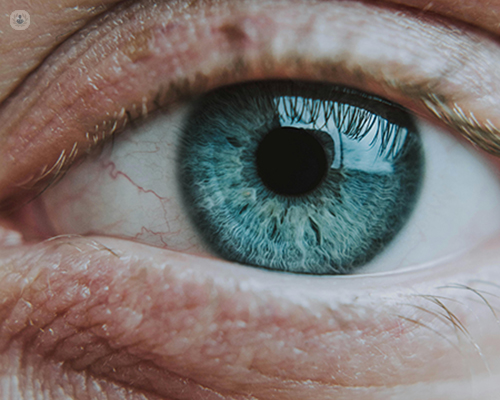Blepharoplasty explained: Types, recovery, and results
Written in association with:In his latest online article, renowned consultant ophthalmic and oculoplastic surgeon Mr Jagmohan Chawla offers his expert insight into blepharoplasty. He explains the difference between upper and lower blepharoplasty, the recovery process and how long you can expect the results to last.

What is blepharoplasty and what specific concern is addressed?
Blepharoplasty is a surgical procedure to remove the eye bags and improve the tired-looking appearance of the eyes. This achieves a younger, fresher appearance. An upper blepharoplasty concentrates on the region between the eyebrow and the eyelashes, while the lower eyelid blepharoplasty focuses on the area between the eyelid and the cheek. Essentially, blepharoplasty procedures involve the removal of excess skin and muscle from those areas and repositioning the underlying fat to provide a more youthful configuration.
What are the different types of blepharoplasty procedures available?
There are two different types of blepharoplasty: upper and lower. Upper blepharoplasty can be combined with correction of the droopy eyelid or eyebrow lift. With lower blepharoplasty, the aim is to reduce the pouches and the bulges in the lower eyelid. It can be performed with a transconjunctival approach in younger people, which gives you a scarless result, and also when there is not enough excessive skin to remove. This procedure is preferred in younger people who do not have very excessive redundant skin in the lower eyelid. It can also correct what we call tear trough deformity, and sometimes we also lift the mid-face using this approach.
What is the recovery process like after undergoing blepharoplasty?
Typically, there is always some swelling and bruising in the eyelids, and it takes one or two weeks for the eyes to settle down in upper blepharoplasty. In lower blepharoplasty, it takes a bit longer, up to three weeks. However, if you are working from home, you can restart your work within three to four days. You can get engaged in your routine daily activities which do not require any strain-wise physical exercise.
Are there potential risks or complications associated with blepharoplasty?
All operations carry an element of risk. Fortunately, these risks and complications are temporary, very few and far between, and usually settle down in due course. The main problems encountered with blepharoplasty are swelling, bruising of the eyelids, blurring of vision, gritty feeling in the eyes because of dryness, and watering of the eyes.
At times, you can have under- or over-correction or asymmetry between the two eyes. All these potential problems or complications can be taken care of and are usually discussed during the consultation. A written information leaflet is also provided at the time of consultation to reinforce the discussions about the potential risks and complications.
How long do the results of blepharoplasty typically last?
Baggy eyelids are a manifestation of the ageing process. The majority of patients do not feel the need to have a repeat procedure. Typically, the results last for about five to ten years and it depends on the age of the patient, lifestyle factors like smoking, and other skin disorders, as well as medical conditions like thyroid and eye disease.
Mr Jagmohan Chawla is a renowned consultant ophthalmic and oculoplastic surgeon. You can schedule an appointment with Mr Chawla on his Top Doctors profile.


